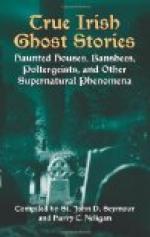Shortly before ’98 he was seen on the Curragh by a blacksmith who was crossing it in an ass-cart from Athgarvan to Kildare. A fairy blast overtook him, and he had just time to say, “God speed ye Gentlemen” to the invisible “Good People,” when he heard horses galloping up behind him; pulling to one side of the road he looked back and was terrified at seeing a troop of knights, fully armed, led by one on a white horse. The leader halted his men, and riding up to the blacksmith asked him to examine his shoes. Almost helpless from fear he stumbled out of the ass-cart and looked at each shoe, which was of silver, and then informed the knight that all the nails were sound. The knight thanked him, rejoined his troop, and galloped off. The blacksmith in a half-dazed state hastened on to Kildare, where he entered a public-house, ordered a noggin of whisky, and drank it neat. When he had thoroughly come to himself he told the men that were present what had happened to him on the Curragh; one old man who had listened to him said: “By the mortial! man, ye are after seeing ‘Gerod Earla.’” This fully explained the mystery. Gerod Earla, or Earl Gerald, is the name by which the Wizard Earl is known by the peasantry.
One other legend is told in connection with the Wizard Earl of a considerably later date. It is said that a farmer was returning from a fair in Athy late one evening in the direction of Ballintore, and when passing within view of the Rath of Mullaghmast he was astonished to see a bright light apparently issuing from it. Dismounting from his car he went to investigate. On approaching the Rath he noticed that the light was proceeding from a cave in which were sleeping several men in armour, with their horses beside them. He cautiously crept up to the entrance, and seeing that neither man nor beast stirred he grew bolder and entered the chamber; he then examined the saddlery on the horses, and the armour of the men, and plucking up courage began slowly to draw a sword from its sheath; as he did so the owner’s head began to rise, and he heard a voice in Irish say, “Is the time yet come?” In terror the farmer, as he shoved the sword back, replied, “It is not, your Honour,” and then fled from the place.
It is said that if the farmer had only completely unsheathed the sword the enchantment would have been broken, and the Earl would have come to his own again.
In 1642 Wallstown Castle, the seat of the Wall family, in County Cork, was burnt down by the Cromwellian troops, and Colonel Wall, the head of the family, was captured and imprisoned in Cork jail, where he died. One of the defenders during the siege was a man named Henry Bennett, who was killed while fighting. His ghost was often seen about the place for years after his death. His dress was of a light colour, and he wore a white hat, while in his hand he carried a pole, which he used to place across the road near the Castle to stop travellers; on a polite request




